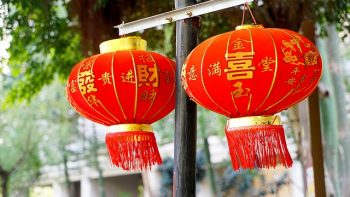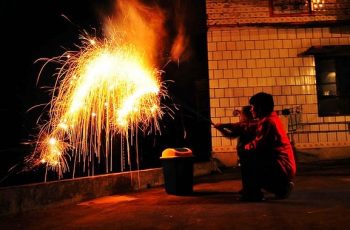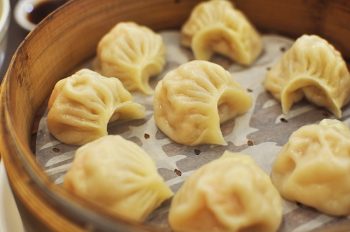4 Useful Verbs for Chinese New Year Posted by Ayana on Jan 6, 2020 in Uncategorized
Chinese New Year, also known as Spring Festival (春节 chūn jié), is celebrated this year on January 25th, 2020. Here are 4 useful verbs to use when talking about the festival customs.
办 bàn = to run, to handle
Spring Festival is China’s most important festival. The week-long national holiday week received the name Chinese Lunar New Year Golden Week (黄金周 huáng jīn zhōu). Actually, observances traditionally take place for more than a week. Fifteen days, to be exact, from the evening preceding the first day of the year to the Lantern Festival, held on the 15th day of the year. The holiday has plenty of traditions and rituals. Among them is the New Year’s dinner (年夜飯 nián yè fàn), held on New Year’s Eve during which family members get together from all around China to celebrate.
With so many events, the celebration requires lots of preparation. The markets fill up with Spring Festival goods (年货nián huò) weeks before the holiday. Spring Festival goods include traditional treats and dishes for the holiday and a variety of food every day, ranging from vegetables and fruits, meats and rice, to beverages and nuts. Many stores and restaurants are closed during the holiday and the Chinese need to prepare food for two weeks, including the big dinner of New Year’s Eve, in advance. Spring Festival goods also include decorative items (装饰用品 zhuāng shì yòng pǐn), gifts, clothes, New Year couplets, red envelopes (红包 hóng bāo), and so on.
At the end of each lunar year, Chinese are busy shopping and preparing (办年货 bàn nián huò) for the coming new year. 办年货 actually means to go to the streets and markets to buy all it needs for the New Year Festival.
每逢农历新年,家家户户总会忙着办年货。
Měi féng nóng lì xīn nián, jiā jiā hù hù zǒng huì máng zhe bàn nián huò.
Every Lunar New Year, every household is always busy with shopping for the new year.
贴 tiē = to stick
Chinese New Year Couplets (春联 chūn lián) decorate most doors throughout China during the celebration of Chinese New Year. Pasted on both sides of the front door these two vertical red couplets (对联 duì lián) are a common sight both in the large cities and in the countryside of China. Written with black or golden ink, the couplets are composed of a pair of poetry lines with parallel structures and antithetical meanings, accompanied by a four-character horizontal scroll affixed above the door frame. A couplet, for example, could be:
竹笋破冰辞旧岁
Zhú sǔn pò bīng cí jiù suì.
The bamboo shoots break ice to send away the old year
Parallel to:
红梅得意闹新春
Hóng méi dé yì nào xīn chūn
The red plums bloom gaily to greet the new spring
While the scroll above read:
迎春接福
Yíng chūn jiē fú
Happy and prosperous New Year
The markets fill up with 年货, and many hanging red scrolls decorate the stalls, ready to be sold. It is a spectacular sight: endless red strips serve as a backdrop for calligraphy artists who spend the hours on the market writing new couplets every day. Pasting spring couplets (贴春联 tiē chūn lián) is an old custom, and every household buys a joyful and prosperous couplet to paste on its entrance.
放 fàng = to set off
As the legend goes, a fearsome monster called Nian would emerge from his den every year just before the spring arrived, hunting for villagers and livestock. One day, the villagers discovered that burning dry bamboo would produce a startling explosive sound, scaring away the monster. Since then, it has become a tradition at Chinese New Year. After gunpowder was invented 2,000 years ago, firecrackers replaced the bamboo. Nowadays, the common Chinese name for firecrackers is 鞭炮 (biān pào). But another Chinese name for firecrackers – 爆竹 (bào zhú) – implies this old history: 爆 means to explode, and竹 means bamboo.
Many people still believe that exploding firecrackers (放鞭炮 fàng biān pào) will scare away the evil spirits of the past year. Lighting fireworks becomes a major custom during the Chinese New Year as a way to celebrate and enhance the festive atmosphere. They are exploded day and night, before and even after the Spring Festival. On the streets, from the rooftops, and out of windows, they are everywhere. Firecrackers are also used as decorations, hanging alongside door entrances, embellishing shopping centers, restaurants, and hotels.
放爆竹是中国传统民俗。
Fàng bào zhú shì zhōng guó chuán tǒng mín sú.
Setting off firecrackers are a traditional Chinese folk custom.
包 bāo = to wrap
Eating dumplings (饺子 jiǎo zi) on Spring Festival is a popular Chinese custom, typically in northern China. Eating though, is only a part of the custom. Usually, the family gathers together on the Lunar New Year’s Eve to make the dumplings and wrap them (包饺子 bāo jiǎo zi) one by one. The dumplings should be cooked before midnight, so they can be eaten on the first hour of the new year.
The custom originated from the phrase更岁交子 (gēng suì jiāo zi). The phrase consists of two verbs: 更 (to change), and 交 (to arrive at); and two time terms: 岁(year), and 子, a short of 子时 (zǐ shí) – the first period of the day according to the ancient Chinese time system that divides each 24-hour day into 12 two-hour periods. The phrase refers to the timing of the years’ exchange: the new year arrives at the first period of the day (11 pm-1 am) and replaces the old year.
Chinese has a significant number of homophonous syllables. 交子(jiāo zi) pronunciation, for example, is similar to饺子 (jiǎo zi), which created the homophonic phrase 更岁饺子 (gēng suì jiǎo zi), literally translated to as the year changes – dumplings. This pun produced the New Year tradition of eating dumplings to send away the old and welcome the new. A fun custom associated with the tradition is to hide a coin in one of the dumplings. The person who bites the coin is said to be lucky and prosperous in the New Year.
Text vocabulary
春节 chūn jié = Spring Festival, Chinese New Year, Lunar New Year
黄金周 huáng jīn zhōu = golden week, a weeklong holiday
年夜飯 nián yè fàn = New Year’s dinner
年货 nián huò = Spring Festival goods
装饰用品 zhuāng shì yòng pǐn = decorative item
红包 hóng bāo = red envelope
办 bàn = to run, to handle
对联 duì lián = couplets
春联 chūn lián = Spring Festival couplets
贴 tiē = to stick
鞭炮 biān pào = firecracker
爆竹 bào zhú = firecracker
放 fàng = to set off
饺子 jiǎo zi = dumplings
包 bāo = to wrap
好好学习,天天向上!

Build vocabulary, practice pronunciation, and more with Transparent Language Online. Available anytime, anywhere, on any device.







Leave a comment: